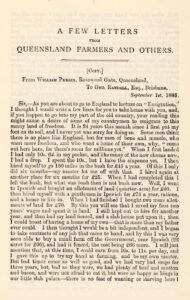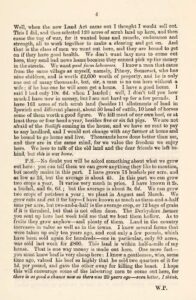
Rosewood History
William PERREM and Elizabeth WINDSOR
Name: William PERREM
Aka: PERRIM, PERRAM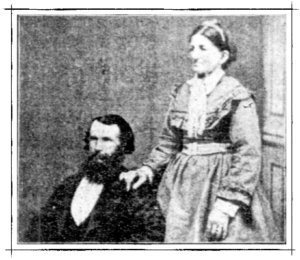
Occupation: Farmer – “Epsom Farm”
Birth: 22nd November 1836, Pitney, Somersetshire, England
Immigration: 19th September 1858, the Alfred arrived Moreton Bay, NSW from Birkenhead
Residence: Lanefield, Queensland
Death: 16th June 1922, Rosewood, Queensland aged 85 years
Burial: 18th June 1922, Tallegalla Pioneer Cemetery
Religion: Wesleyan Methodist; Congregational
Father: William Junior PERRIM
Mother: Harriet COX
Spouse: Elizabeth WINDSOR
Birth: 31st January 1830, Huish Episcopi, Somerset, England
Immigration: 19th September 1858, The Alfred arrived Moreton Bay, NSW from Birkenhead
Residence: Lanefield, Queensland
Death: 15th January 1908, at home in Rosewood, Queensland aged 77 years
Burial: 17th January 1908, Tallegalla Pioneer Cemetery
Religion: Wesleyan Methodist; Congregational
Father: George WINDSOR
Mother: Sarah PRIOR
Marriage: 6th June 1858, Huish Episcopi, Somerset, England
Children: 7
William Alfred PERREM (1858-1858)
William PERREM (1860-1939) = Sarah THOMPSON
Harriett Caroline PERREM (1861-1929) = Wallace Henry COLLETT
Frederick George PERREM (1864-1944) = Bridget GRIMSEY
Hezekiah PERREM (1865-1892)
Celina Sarah PERREM (1867-1940)
James PERREM (1869-1934) = Mary DODD
The voyage on the Alfred was described as one of the most prosperous on record yet it was not uneventful. Traditionally when ships crossed the equator (“crossing the line”), humorous ceremonies were held on board. Rookie seamen and 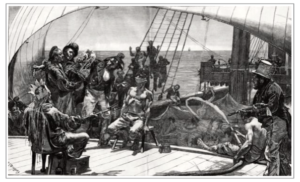 passengers were charged with “presuming to cross the line without seeking prior consent from King Neptune”. Someone would dress up as King Neptune and take a seat on the saloon deck. Other crew members took their place beside him in so called “seats of justice”. This was usually accompanied by a fanfare of bugles. Those who were crossing the line for the first time were presented to King Neptune to be examined and duly sentenced. The punishment was to have their faces covered with a mixture of flour and soot and being shaved with a wooden razor. This was followed up with a salt water bath. Anyone who paid 6d was exempt. The ladies were not always excluded. Exemption for them also cost 6d. Otherwise they would be shaved and expected to kiss all of the “court officials”. It was all a lot of riotous fun!
passengers were charged with “presuming to cross the line without seeking prior consent from King Neptune”. Someone would dress up as King Neptune and take a seat on the saloon deck. Other crew members took their place beside him in so called “seats of justice”. This was usually accompanied by a fanfare of bugles. Those who were crossing the line for the first time were presented to King Neptune to be examined and duly sentenced. The punishment was to have their faces covered with a mixture of flour and soot and being shaved with a wooden razor. This was followed up with a salt water bath. Anyone who paid 6d was exempt. The ladies were not always excluded. Exemption for them also cost 6d. Otherwise they would be shaved and expected to kiss all of the “court officials”. It was all a lot of riotous fun!
One of the other passengers, Ernest King, wrote a poem about the crossing the line ceremony held on the Alfred. Read THE “ALFRED” CROSSING THE LINE.
After their arrival at Brisbane William and Elizabeth Perrem caught the steamship Breadalbane to Ipswich. With them was their baby son, William Alfred, who was born at sea 6 days before the ship reached the Australian shore. Another newly wed couple from Somerset was travelling on the steamer. Charles and Emily Dutney also immigrated on the Alfred. I don’t know if they knew each other before the voyage, but the Perrem’s and Dutney’s paths were destined to cross again. They would become friends who shared many experiences in their new homeland and became pioneers of the Rosewood district.
William and Elizabeth were engaged by Mr. Joshua Peter Bell on Jimbour Station. About a year later they returned to Ipswich and stayed at Newtown for some time. They moved to the Old Racecourse, later known as The Grange (Raceview), where they grew cotton. While they were there the Wesleyans and Methodists held church services in the Perrem’s home.
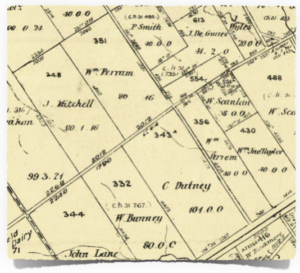
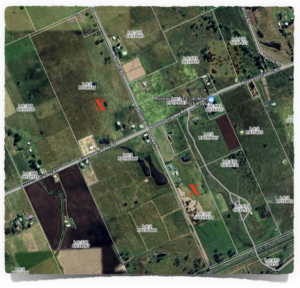
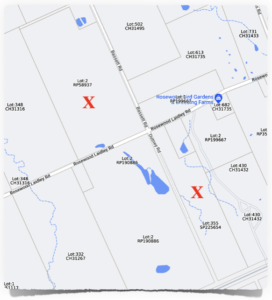
In 1869 William selected Portion 351 (80 acres) in the parish of Walloon near Brandy Gully. On 7th May 1880 he selected Portion 356 (40 acres) in the Parish of Walloon.
Unfailingly, on Sundays, the family walked almost four kilometres to Rosewood Gate to the old building which used to be the Rising Sun Hotel. Church services were held there until a Wesleyan Methodist chapel opened at Lanefield on 10th August 1873. William always took an active interest in religious matters, and he was trustee and steward of the Church. He was also superintendent of the Sabbath school for the many years.
William was a dairy and small crop farmer growing maize, oats, lucerne, pumpkins and melons. He was a great bee-keeper and won first prize for an exhibit of honey at the Rosewood show in 1888.
He was one of the founders of the Farmers’ Club in 1877 and a member of its first committee. In 1911, when life membership badges were awarded by the Rosewood Agricultural and Horticultural Association, William Perrem’s name was omitted from the list of men entitled to badges. When this mistake was realised it was hastily rectified and William was presented with his badge.
William owned considerable property in Ipswich, Brisbane, Southport, and Sandgate.
In June 1899 he sold his farm at Lanefield to Mr. Charles Jacobs (late of Allora, formerly of Rosewood), and built a cottage on his farm close to Rosewood. The local contractor, John Thompson, built their house for them.
The sadness of Elizabeth’s death in January 1908 was highlighted by the fact that she and William would have been celebrating their golden wedding anniversary in another five months.
William lived with his daughter Celina in Matthew Street in the years before he died. Nurse Annie Hines attended him during his final weeks.
An informative article was written about William’s life. It was published in the Queensland Times on Saturday, 26 September 1914 on page 10. It’s an interesting read.
MR. WILLIAM PERRAM OF ROSEWOOD. (By “Red Gum.”)
SEVENTY-EIGHT YEARS OF AGE – FIFTY-SIX YEARS IN QUEENSLAND – A PIONEER AT ROSEWOOD.
The central figure is an old and well-known colonist, namely Mr. William Perram, who has just passed his 56th year mark as a resident of what is now Queensland, having arrived in Moreton Bay on the good ship Alfred, on the 19th of September, 1858.
Mr. Perram was born on the 22nd November, 1836, his birth-place being in Somersetshire. He was the only son of five children, and his mother died when he was about four years of age. His father was a thatcher and builder.
Mr. Perram states that at an early age he was obliged to go to work on a farm, but, being of a roving inclination, he travelled through many parts of England in search of employment, until he accepted an engagement with a gentleman who had not long previously returned from Australia, where he had made a fortune. This fact induced the subject of this sketch no turn his thoughts over the sea to the far off new land, and he finally resolved to try his luck there.
He was married on the 6th of June, 1858 and sailed away from Birkenhead, England, 13 days later, arriving, as stated above, in Moreton Bay on the 19th of September, 56 years ago. Included among his ship-mates were the parents of Mr. Roderick McLeod (including Mr. Roderick himself) of East Ipswich, Mr. George Nash, Warwick-road, and the late Mr. Frederick Wilce, of West Ipswich.
Four days subsequent to their arrival at the immigration depot, Brisbane, Mr. and Mrs. Perram were engaged for 12 months at £40 a year and rations by the late Mr. Thomas Bell of Messrs. Bell and Sons, to go to Jimbour Station, Dalby way. They came to Ipswich by steamer, arriving at the “head of navigation” on the 27th of September, and put up at the Royal Oak Hotel, Bell-street (now the site of the Caledonian Hotel), the then proprietor being the late Mr Harry Skinner. Mr. and Mrs. Perram remained there for a couple of days, when thy took their “passage” on a horse-team bound for their destination Jimbour, or as they were told, “Myall Creek,” but, said Mr. Perram, “we had not the slightest idea where ‘Jimbour,’ ‘Myall Creek,’ or ‘the Condamine’, was situated.
They arrived at “The Swamp (Toowoomba) on the 6th of October. While camped there Mr. Perram did some ploughing for the hotelkeeper (whose name he thought was a Mr. Mole), and planted between three and four acres of maize. The hotel building was a low, wooden erection. At ” The Swamp” they met the late Mr. “Barney” Sloan, to whose bullock-team Mr. and Mrs. Perram were transferred and were conveyed to Jimbour Station, which they reached on the 15th of October.
“The new-chums” quickly settled down to their new conditions of life. A Mr. Broadbent was manager, and Mr. S. Grimley was employed in office-work on the station. Mr. Grimley subsequently entered into partnership with a Mr. Hunter in Ipswich, and the firm was styled Messrs. Grimley and Hunter, merchants, East-street, Ipswich.
Mr. Perram was duly initiated into the mysteries of “bush-life,” which he thought was very free and remarkable, as compared with the life in England. He remained on Jimbour only eight months, as, having had a bad attack of sandy blight, his employers cancelled the agreements, and allowed him to re-turn to Ipswich with the bullock drays.
Mr. Perram, on arrival at the Three-Mile Creek, engaged with Mr. W. Marks, proprietor of the hotel there, for six months as general hand. This term having been completed he came into Ipswich, and accepted a 12 months’ engagement with the late Mr. Richard Wright, a well-known butcher, of Nicholas-street, in those days, whose business as conducted on the site of Messrs. S. Watson Bros’ new building.
Mr. Perram was employed at Mr. Wright’s slaughtering yards at Bundanba, the late Mr. Joseph Parker then being the slaughterman, and the late Mr. William Coleman the shopman at Ipswich. Mr. Perram remained at this job for 12 months, during which time he bought three allotments of land, in Newtown, from the late Mr. John Rankin , who resided on “Rosehill”, on a site opposite the residence of Mr. James Cribb, M.L.A.. This property was next to the residence of the late Mr. W. Squires, and Mr. Perram says he was not long before he made a garden, following the example of his neighbour, Mr. Squires. At a later period, both Mesdames Squires and Perram brought the vegetables so grown to Ipswich in baskets and disposed of them to the towns-people.
After the termination of his engagement with Mr Richard Wright, the butcher, he again entered the employment of Mr. Thomas Bell, at “Mary Vale,” on Limestone Hill, the then residence of the late Hon. Thomas de Lacy Moffatt, Mrs. Moffatt having been a Miss Bell. While working at “Mary Vale”, he met Mr. James Ball, of Nicholas-street, as well as Mr. Thomas Lavercombe, of Newtown, whom he had known for the past 54 years.
At a later period he was employed at Panton’s old stone stores, situated in Thorn-street, overlooking the river, and there were likewise engaged by the late Mr. John Panton, in various occupations. Messrs. John Castles, James Payne, Martin Suthers, Wm. Callow, Michael Quirk, C. C. Cameron, David Hughes, and J.J. Maxwell – all of whom have passed over to the great majority. He also worked for the late Mr. F. A. Forbes and Messrs. G.H. Wilson and Co. He was engaged in the excavation, in Limestone-street, at the front part of Wilson’s old store, for a brick foundation laid by the late Mr. William Hancock, a well-known contractor of the early six-ties and seventies, the veteran Mr. Harry Evans being the brick-layer.
Mr. Perram subsequently purchased 22 acres of land at Raceview, and put it all under cotton. This was about the period when the late Sir. Joshua Peter Bell established a cotton-ginning establishment on his cotton plantation on Bundanba Creek, opposite the residence of Mr. McPhie. While a resident at Raceview, Mr. Perram says that a blackfellow entered his home early one morning, and the aborigine was sorry, thought Mr. Perram, that he so intruded, as he (Mr. Perram), was always a good marksman. The ebony burglar was presented with a quantity of shot, and he never came back for a second “presentation.”
At the time of the rush to Gympie, after the discovery of gold in that district, in 1867, Mr. Perram was one of those who “humped” his swag to seek for wealth, but he found very little of it. He visited the Gympie goldfields several times, and on one occasion he and his mate (the late Mr. Charles Dutney, father of Mr. George Dutney, of Rosewood), were lost in the Kilcoy Ranges.
Previous to the Gympie rush, Mr. Perram states that he accepted an engagement with the late Mr. John Malbon Thompson, of “Cothill,” on the eastern side of Silkstone. Mr. Thompson was cultivating tobacco at the time in partnership with the late Mr. Thomas Dibley, since a member of Parliament representing Woolloongabba.
In 1869 Mr. Perram selected land in the Rosewood Scrub, near Brandy Gully, but he continued to grow cotton at Raceview until the early seventies. The 1870 season was his most profitable year. He sent to England, through Messrs. Cribb and Foote, 3,458 lb of clean cotton, receiving thirteen pence per lb for it, and he sold in seed, 3,167 lb in Ipswich, at 3d per lb.
In 1871 he removed his family to Rosewood, subsequent to selling his farm at Raceview to Mr. John Marsh. “While I resided at Newtown ,” said Mr. Perram, “I made friends with the late Mr. and Mrs. Charles Dutney and Mr. and Mrs. Robert Elliott, of West Ipswich. Mrs. Robert Elliott has since died.”
Since Mr. Perram’s residence in the Rosewood district, he has worked very strenuously for its welfare, particularly in Church and school matters. During his early residence there, church services were held, alternately, in an old public-house (one time the Rising Sun Hotel), by visiting preachers from the Congregational and Wesleyan Churches of Ipswich. With the assistance of Messrs. Walter Bunney, Chas. Dutney, and John Lane, Mr. Perram’s efforts were a success in the establishment of a Methodist Church at Edenmore, Lanefield, on Mr. Lane’s property.
He also worked zealously for the formation of an agricultural and horticultural society in Rosewood, and the first show was held in August of 1878. Some of his co-workers were Messrs. John Mitchell (president), John W. Vance, Patrick O’Donnell, Mark Bensley, Nicholas Wiegand, Charles Cowell, L. Smallbone (treasurer), and F. W. Johns (secretary, also head master at the State School.
Mr. Perram was treasurer of the first State School established at Rosewood. He states that Mr. H. M. Stevens, M.L.A. and himself escorted the first manager of the Royal Bank to his business quarters at Rosewood.
In 1889 the Lanefield Dairy Company was formed, with the following directors: Messrs. Charles Horne, Walter Loveday, sen., Geo. H. Dutney, Wm. Berlin, J. L. Lambert (M.L.A., for Rosewood), H. M. Stevens (chairman), and W, Perram (treasurer). During the big flood of 1893 they sent down about a ton of butter by railway for Brisbane, but the train could get no farther than Ipswich owing to the extraordinary height of the flood water. Only 5d. per lb was offered, for the lot in Ipswich. They eventually got the butter through to the metropolis, where they disposed of it at 1s per lb.
In connection with the erection of the provisional State school at Lanefield, Mr. Perram said that, during one day’s collection in Brisbane, he garnered in 133 sovereigns and 30 half-sovereigns, and thought that was “good work “
Mr. Perram sold his farm at Lanefield in June of 1899 to Mr. Charles Jacobs and subsequent to the death of Mrs. Perram, he has been residing at Rosewood with his daughter, Miss S. S. Perram.
In the course of a conversation, he said he remembered the mails being brought from Brisbane to Ipswich on horse-back in 1859. He also recollected Police Court proceedings being conducted by the late Col. C. C. Gray in Brisbane-street, in a building on the site of Mr. M. J. Molloy’s tobacconist shop. He likewise recalled to memory the arrival in this city, at the end of 1859, of the late Sir George Ferguson Bowen, first Governor of Queensland. He remembered, among other places, the post-office being situated in Bell street, the late Mr. Richard Gill being in charge; the Government road depot in Brisbane-street, then situated on the site of the Oakdale Private Hospital, on the corner of Milford and Brisbane Streets; the pontoon bridge across the river, in charge of the late Mr. Robert Jefrey, as well as the following medical gentlemen – Drs. W. M. Dorsey, H. Challinor, T. Rowlands, and K. I. O’Doherty. He also witnessed the champion race won by the late Mr. John Tait’s Zoe, in 1861, and he remembered the turning of the first sod at North Ipswich of the Queensland railway system, in 1864, and he has a distinct recollection of the drought of 1877, when the Government had to send water to Rosewood by rail.
Altogether Mr. Perram has been a very busy colonist and he says that he enjoys splendid health. Farther, he stated that his eyesight was so good that he believed he could still “pot” a hare on the run.
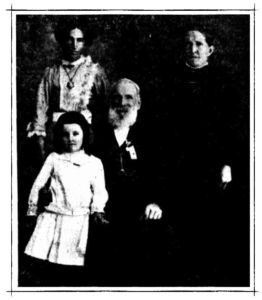
FOUR GENERATIONS
Mr. William Perrem, Rosewood; Mrs. W. H. Collett (daughter), Rosewood; Mrs. Maud Henning (granddaughter), Rosewood; Edna May Henning (great granddaughter), Rosewood.
In 1881 a government appointed emigration agent named George Randall, who confounded the government by not requesting a salary, toured England encouraging agricultural labourers experiencing depressed conditions to migrate. Randall then toured through Queensland to find out how the migrants were faring. Many farmers wrote letters to him and the following pages were published in a book named “A Few Letters From Queensland Farmers And Others”, published at his request in 1886.
